SystemVerilog Cheatsheet
Table of Contents
- 1. Compile/Run
- 2. Modules
- 3. Data Types and Values
- 4. Operations and Conditions
- 5. Synchronous logic and assignments (alwaysff)
- 6. Finite State Machines
- 7. Testbench
1. Compile/Run
1.1. TL;DR
cdto foldervlib workon first runvlog <filename>.svto compile all relevant .sv filesvsim <testbench-name>to run your file (usually a testbench)add wave sim:/<testbench-name>/uut/*- Run your simulation using either:
run <N>to run for <N> nanosecondsrun -allto automatically stop testbench when completed
vlogto recompile relevant modules as neededrestart -fto restart your simulation
To run .tcl scripts, use source <script-name>.tcl.
1.2. Detailed Explanation:
- Navigate to your project directory using
cd.
The path should:- Use these slashes: ’/’
- Use English characters
- Not have any spaces (alternatively, it use quotes “”)
- Create a ’work’ library using the command
vlib work.- This is supposedly mandatory.
- Only needs to be performed while running your project for the first time.
- Compile your .sv files using
vlog- If some files depend on modules from other files,
You will have to compile these files first.
- If some files depend on modules from other files,
You will have to compile these files first.
- When running testbench, recompile relevant modules as needed using
vlog- You only need to recompile the relevant modules.
- No need to recompile the testbench itself or any other modules.
2. Modules
2.1. Defining a module
- Everything you write in SystemVerilog must be inside a module.
A module is a fundemental building block that receives inputs and generates outputs.
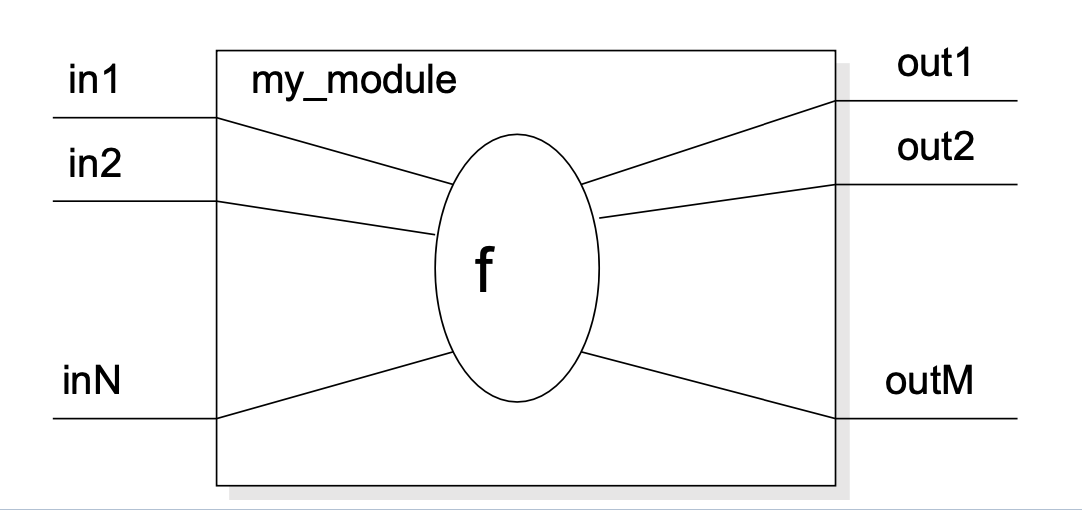
Here’s an example module:
// [a,b] -> [my_module] -> [result = (a AND b)] module my_module( // Input and Output Declaration input logic a, input logic b, output logic result); // Declarations of "f" assign result = a & b; endmodule
2.2. Creating module instances (instantiation)
2.2.1. Positional association
Define an instance of a module according to its argument positions, as such:
module_name instance_name (
my_input1,
...,
my_inputN,
my_out1,
...,
my_outM
);
2.2.2. Named association
Modules can also be instantiated using its arguments’ names explicitly:
module_name instance_name2 ( .in1(my_input1)), ..., .inN(my_inputN), .out1(my_output1), ..., .outM(my_outputM) )
2.3. Parameters
- Allows to pass parameters to a module per-instantiation.
- Note: different from logic inputs and outputs.
2.3.1. Definition inside a module declaration
module some_module ( input logic in1 output logic out1 ); parameter param1 = 1; // 1 is a default value parameter param1 = 2; parameter param1 = 3; endmodule
2.3.2. Usage when instantiating a module
A module that shifts a number left N times.
module shift_N ( output logic [3:0] out, input logic [3:0] a ); parameter N = 1; always_comb begin out = a << N; end endmodule
Here are some usage examples:
module multiple_shifts ( input logic [3:0] a, output logic [3:0] b, output logic [3:0] c ); // Output a 2 shift result to b shift_N #(.N(2)) shift_2(.a(a), .out(b)); // Output a 3 shift result to c shift_N #(.N(3)) shift_3(.a(a), .out(c)); endmodule
2.3.3. Local Parameters
Store constant values inside a module. These cannot be changed or passed to an instance module.
Here’s an example:
module my_module(...); localparam N = 2'b11; localparam NUM_OF_CYCLES = 10; endmodule
2.4. Modules Inside Modules
2.4.1. Using modules inside other modules
// Mux that takes 2-bit inputs and outputs a 2-bit result module mux2to1_2bit ( output logic [1:0] O, input logic [1:0] A, input logic [1:0] B, input logic S ); // Use instances of existing 1-bit input muxes mux2to1_1bit mux1(.O(O[1]), .S(S), .A(A[1]), .B(B[1])); mux2to1_1bit mux0(.O(O[0]), .S(S), .A(A[0]), .B(B[0])); endmodule
2.4.2. Generating many module instances at once (generate)
You can use the generate command to create many module instances at once:
module mux2to1_32bit ( output logic [31:0] O, // 32-bit output input logic [31:0] A, // 32-bit input A input logic [31:0] B, // 32-bit input B input logic S ); genvar i; generate for (i = 0; i < 32; i++) begin mux2to1 mux_inst(.O(O[i]), .S(S), .A(A[i]), .B(B[i])); end endgenerate endmodule
2.5. Concurrent assignment (השמה של ערכים מקבילים/ברי שינוי) to wires inside modules
Connect a wire to some combinatorical logic or another wire.
2.5.1. Syntax
// A simple assignment from one wire to another module pass_same_value( output logic Z, input logic A ); assign Z = A; endmodule // Assigning some concurring calculation to wire module and_module ( output logic Z, input logic A, input logic B ); assign Z = A & B; endmodule
An explicit value can also be used.
logic signal; assign signal = 1'b0;
2.6. Procedular Blocks (הרצה סדרתית של הצהרות בתוך מודול)
2.6.1. Definition and types
All statements inside a procedural block are executed sequentially.
There are two procedural constructs in Verilog:
initialalways_combWe will only use
initialin simulations (testbenches). For regular modules, we usealways_comb.
2.6.2. alwayscomb
Executes statements in a loop. Used for combinatorical logic implementation.
Here’s a working example:
module and_module( output logic Z, input logic A, input logic B ); always_comb begin Z = A & B; end endmodule
You can use conditional statements inside of a procedural block.
2.6.3. Complete assignments
Note: always_comb should NOT be used for memory elements!
- If a signal is not assigned in a certain flow, a memory element is implicitly created to preserve the previous value.
- Usually, this is a bug.
- Always use complete assignments.
3. Data Types and Values
3.1. SystemVerilog Logic Values
In SystemVerilog, a bit can take the following logical values:
| Logic Value | Meaning |
|---|---|
| 0 | zero / logic low / false / ground |
| 1 | one / logic high / true / power |
| x | not initialized or collision |
| z | unconnected |
3.2. 1-bit wires (logic)
The logic data type represents a wire (1 bit):
logic a,b,c,d,e;
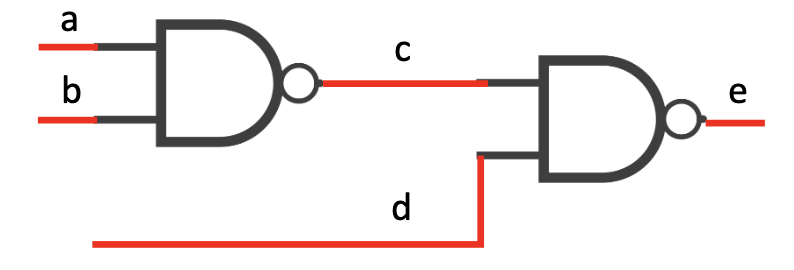
3.3. Vectors
Declaration of an 8-bit logic vector:
logic [7:0] w1; //w1[7] is the MSB
Here’s how you’d describe the “selector” wires in a mux module declaration:
module mux4tol( output logic O, input logic D0, input logic D1, input logic D2, input logic D3, input logic E, input logic [1:0] S ); // declarations // description of a mux endmodule

3.3.1. Vector Operations
Bit select:
w1[3]Range select:
w1[3:2]
Pack:
vec = {x, y, z};Unpack:
{carry, sum} = vec[1:0];
3.3.2. Repeated Signals
A signal can be repeated \(n\) times in this manner:
vec = {16{x}} // 16 copies of x
3.3.3. A Working Example (Implementing Unsigned Extension)
logic [7:0] out; logic [3:0] A; out = {{4{1'b0}}, A[3:0]};
3.4. Integer Literals
Format: <width’><signed><radix> value
You can use this format to generate:
- Multiple bit integers (
<width'>) - Two’s complement negative numbers (
<signed>) - Write a number in base 2,8,10 or 16 (
<radix>)
3.4.1. Available number bases (<radix> values)
- Binary (
borB) - Octal (
oorO) - Decimal (
dorD) - Hexadecimal (
gorG)
3.4.2. Default settings
- Width = 32
- Unsigned
- Radix = Decimal
3.4.3. Examples
1'b0- one bit, unsigned, value of zero12'hAD1- 12 bits, unsigned, value of 0xAD112'b1010_1101_0001- 12 bits, unsigned, value of 0xAD114- defaults: 32 bits, unsigned, value of 14-14- 32 bits, signed, value of -14
3.5. Blocking and non-blocking assignment
3.5.1. Blocking assignment
Acts much like in traditional programming languages. The whole statemnt is done before control passes on to the next statement.
In always_comb, we use a blocking assigment:
logic a, in; always_comb begin a = in; end
3.5.2. Non-blocking assignment
Evaluates all the right-hand sides for the current time unit. Assigns the left-hand sides at the end of the procedural block.
Basically, allows behavior of a shift register.
This is how you’d implement a shift behavior between Flip-Flops:
module shifter ( input logic in, input logic clk ); logic A, B, C; always_ff @(posedge clk) begin A <= in; B <= A; C <= B; end endmodule

And this is what happens when you accidentally use blocking assignments instead:
module bad_shifter ( input logic in, input logic clk ); logic A, B, C; always_ff @(posedge clk) begin A = in; B = A; C = B; end endmodule
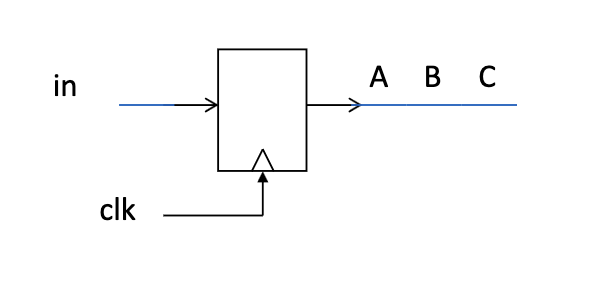
3.6. enum
An enum type defines a set of named values.
We will use enum for FSM state declaration:
logic [7:0] out; logic [3:0] A; out = {{4{1'b0}}, A[3:0]};
typedef enum {idle_st, state1, state2} state_type;
4. Operations and Conditions
4.1. Logic Gates (built-in)
The following logic gates are available for direct instantiation:
- and
- or
- not
- xor
- nand
- nor
- xnor
Syntax:
gateName(output, input1, <optional_input2>)
4.1.1. Example implementation of a half hadder
module HalfAdder ( output logic S, output logic C, input logic A, input logic B ); xor(S, A, B); and(C, A, B); endmodule
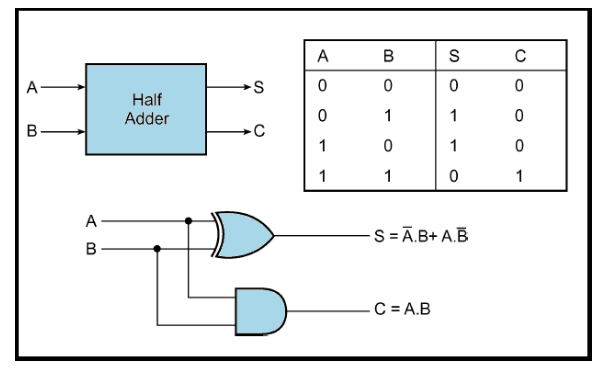
4.2. Operators (built-in)
4.2.1. Bitwise Operators
&- bitwise AND|- bitwise OR~- bitwise NOT^- bitwise XOR~^/^~- bitwise XNOR
4.2.2. Shift
>>- shift right<<- shift left
For example,
b = 4'b1010 << 2; // b = 4'b1000 c = 4'b1010 >> 1; // b = 4'b0101
4.2.3. Operator Precedence

4.3. Logical Operators
4.3.1. Relational Operators
| Operator | Meaning |
|---|---|
| < | Less than |
| <= | Less than or equal to |
| > | Greater than |
| >= | Greater than or equal to |
| == | Equal to |
| != | Not equal to |
All of these return a 1-bit logical value (true/false/x)
4.3.2. Logical Operators
Used for conditions.
| Operator | Meaning |
| && | Logical AND |
| || | Logical OR |
| ! | Logical NOT |
- Operands evaluated to a 1-bit value: 0 (false), 1 (true) or x
- Result is a 1-bit value: 0 (false), 1 (true) or x.
4.3.3. Operator Precedence
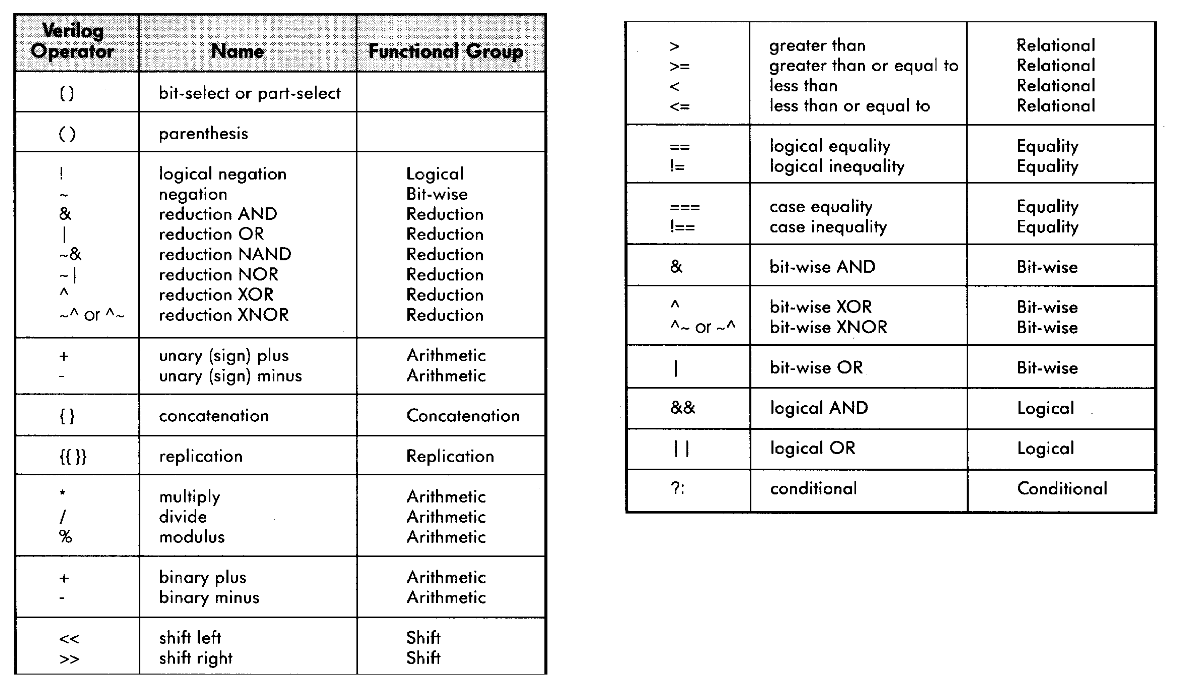
4.4. Conditional Statements
Used in procedural blocks.
4.4.1. if
- Syntax
if (condition1) begin <statement1>; end else if (condition2) begin <statement2>; end else begin <statement3>; <statement4>; end
- A working example
module mux ( input logic A, input logic B, input logic sel, output logic Q ); always_comb begin if (sel == 1'b0) begin Q = A; end else begin Q = B; end end endmodule
4.4.2. case
- Syntax
case (<signal/expression>) <value1>: begin <statement1>; end <value2>: begin <statement2>; end default: begin <statement4>; end endcase
- A working example
An example for mux behavior using
case.module case_example ( input logic A, input logic B, input logic [1:0] w, output logic Y ); always_comb begin case (w) 2'b00: Y = A & B; 2'b01: Y = A | B; 2'b10: Y = A ^ B; default: Y = ~B; endcase end endmodule
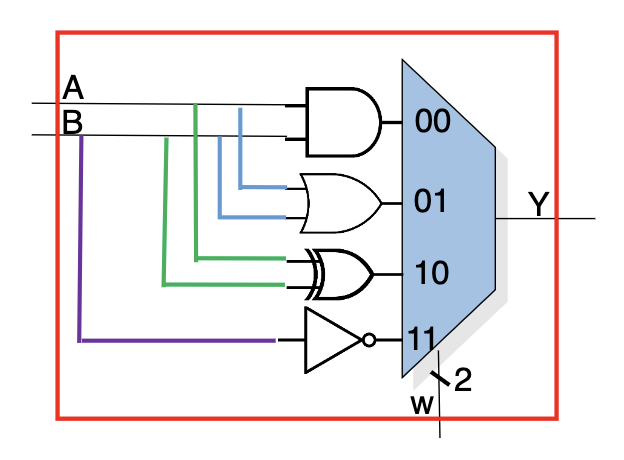
- casez
?andzare considered as don’t cares [0,1,z] - casex
?,xandzare considered as don’t cares [0,1,x,z]
5. Synchronous logic and assignments (alwaysff)
As opposed to always_comb, which implements an asynchronous/combinatorical block,
always_ff implements a synchronous block.
You usually want to use non-blocking assignments with alwaysff.
5.1. Positive Edge (דגימה בעליית שעון)
Using posedge, you can sample a value when your clock is on a positive edge.
This is an example that uses posedge to emulate a Flip-Flop:
logic a, in; always_ff @(posedge clk) begin a <= in; end
5.2. Synchronous Reset
Only occurs on positive edge. This is how you implement it:
always_ff @(posedge clk) begin if (rst == 1'b1) begin <reset statement1>; end else begin <sync statement2>; end end
5.3. Asynchronous Reset
Can occur whenever the reset entrance rises. This is how you implement it:
always_ff @(posedge clk, posedge rst) begin if (rst == 1'b1) begin <reset statement1>; end else begin <sync statement2>; end end
5.4. Implementing a Flip-Flop with Reset
This is how you implement a
6. Finite State Machines
6.1. FSM template
module my_FSM_module ( input logic input1, ... output logic outputN typedef enum { idle_st, start_st } sm_type; // Declaring signals for the next & current state sm_type current_state; sm_type next_state; // ... );
6.2. Next state recipe for synchronous logic
// FSM synchronous procedural block always_ff @(posedge clk, posedge rst) begin if (rst == 1'b1) begin current_state <= idle_st; end else begin current_state <= next_state; end end
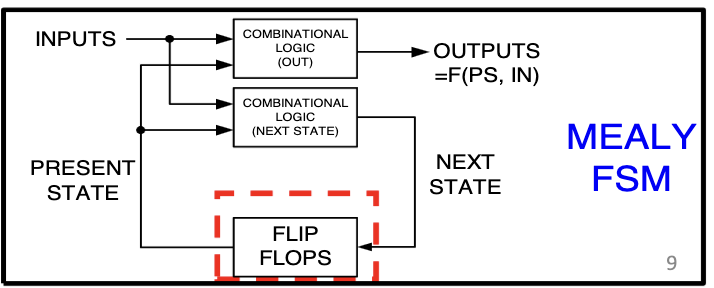
6.3. FSM - (Mealy) Asynchronous Logic
This is how you can use the current state to infer outputs and the next state:
always_comb begin // Default assignments next_state = current_state; output1 = 1'b0; ... outputN = 1'b0 // Specific assignments case (current_state) idle_st: begin next_state = ...; ouput1 = ...; ... outputN = ...; end start_st: begin next_state = ...; output1 = ...; ... outputN = ...; end ... endcase end
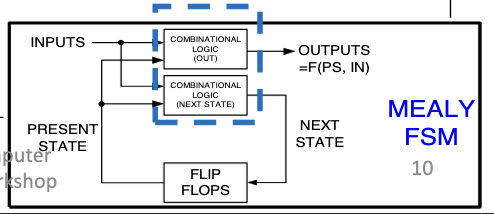
6.4. FSM - (Moore) Asynchronous Logic
always_comb begin case (current_state) S0_st: begin next_state = S1_st; z = 1'b0; end S1_st: begin next_state = S2_st; z = 1'b0; end S2_st: begin next_state = S0_st; z = 1'b1; end default: begin next_state = S0_st; z = 1'b0; end end

7. Testbench
7.1. Unit Under Test (UUT)
A testbench generates input values and checks our Unit Under Test (UUT) for its response.
The UUT in our case is our module.
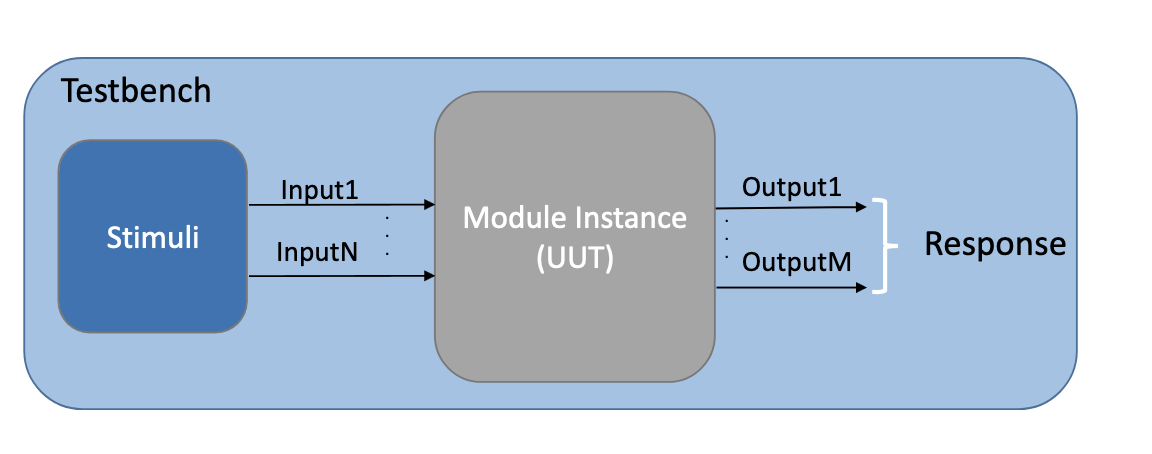
7.2. Generating input values
initial begin data = 0; #50 // Wait 50ns data = 1; #30 // Wait 30ns data = 0; end
Here’s a working example:
// _tb stands for _testbench module HalfAdder_tb; // Definition of testbench input values to UUT logic ha_a; logic ha_b; logic ha_sum; logic ha_carry; // Instance of UUT HalfAdder uut( .a(ha_a), .b(ha_b), .sum(ha_sum), .carry(ha_carry) ); // Generate test input values here initial_begin ha_a = 0; ha_b = 0; #20 ha_a = 1; ha_b = 0; #20 ha_a = 1; ha_b = 1; end endmodule
7.3. Repeat Loop
Used in an initial block to repeat statements.
repeat(num_of_times) begin <statement1>; <statement2>; end
7.4. Synchronous logic: Generating a Clock Signal
This is how you generate a clock signal for simulation 2:
// Start value of clock initial begin Clock = 1'b0; end // Clock behavior always begin #10 Clock = ~Clock; end
7.5. Synchronous logic: Wait X clock cycles
Example: Waiting for 4 clock cycles
initial begin repeat(4) begin @(posedge clk); end end
7.6. How to Debug a FSM
- Always add the current and next state to the waveform
- Given the current state and the inputs, check that the next state and output are as expected
- As always, search for
xandzvalues and ensure they make sense
